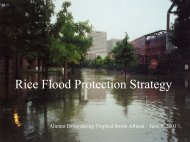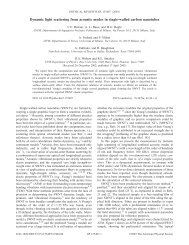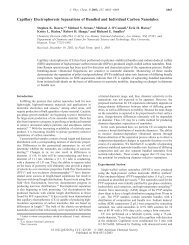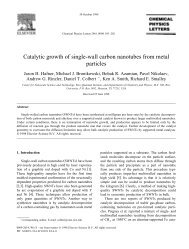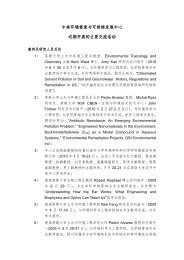Farming vs. Gold Mining in the Nyanga Highlands
Farming vs. Gold Mining in the Nyanga Highlands
Farming vs. Gold Mining in the Nyanga Highlands
Create successful ePaper yourself
Turn your PDF publications into a flip-book with our unique Google optimized e-Paper software.
NYAME AKUMA No. 75 June 2011<br />
and many are on <strong>the</strong> opposite side of <strong>the</strong> platform.<br />
The retention of soil for homestead gardens is a more<br />
consistent <strong>in</strong>terpretation.<br />
Water supply applies particularly to <strong>the</strong> variant<br />
structures of lowland Ziwa, dubbed pit-enclosures,<br />
which have o<strong>the</strong>r features which are <strong>in</strong>consistent.<br />
The platforms of <strong>the</strong>se structures are lower<br />
and <strong>the</strong> pits shallower and smaller (average diameter<br />
3.20m) than <strong>the</strong> upland pit-structures, with <strong>the</strong> usual<br />
dra<strong>in</strong> below (and no radial walls). The upper side of<br />
<strong>the</strong> platform has an enclosure wall around 1.20m high,<br />
greatly thickened around a straight entrance passage<br />
which is often l<strong>in</strong>telled with stone slabs, of <strong>the</strong> familiar<br />
height and width. These passages can be closed<br />
by a built-<strong>in</strong> draw bar, comparable to <strong>the</strong> upland tunnels<br />
closable by dropp<strong>in</strong>g poles through <strong>the</strong> slot.<br />
The tunnel to <strong>the</strong> pit is generally straight with no slot<br />
and starts with<strong>in</strong> <strong>the</strong> enclosure near <strong>the</strong> entrance.<br />
Not all tunnels are roofed; roof slabs could have been<br />
removed for reuse, or <strong>the</strong> l<strong>in</strong>telled enclosure entrance<br />
already provided <strong>the</strong> height restriction. In many cases<br />
<strong>the</strong>se tunnels have been deliberately partly or completely<br />
blocked with stones, which rarely if ever occurs<br />
<strong>in</strong> <strong>the</strong> highland pit-structures. Any water supply<br />
would have to come through <strong>the</strong> entrance passage,<br />
possible but <strong>in</strong>convenient. The majority of such<br />
structures could not be served by furrows. It may<br />
also be noted that many o<strong>the</strong>r Ziwa enclosures have<br />
no pits, though of similar size and shape, with identical<br />
divided houses and raised platforms for storage<br />
huts. These are clearly occupation homesteads, not<br />
<strong>in</strong>dustrial <strong>in</strong>stallations.<br />
There are no pit-structures <strong>in</strong> <strong>the</strong> lowland areas<br />
below <strong>the</strong> nor<strong>the</strong>rn highlands. Here <strong>the</strong> homestead<br />
design is what I have called “double concentric<br />
enclosures” of similar size, with a low and ra<strong>the</strong>r<br />
rough outer wall and a central well-built enclosure,<br />
equivalent to <strong>the</strong> pit <strong>in</strong> size and position. This could<br />
still have accommodated a few cattle (not necessarily<br />
dwarf) but could have no association with gold<br />
extraction.<br />
The same water restrictions apply to <strong>the</strong> terraces<br />
which are not considered <strong>in</strong> her present article,<br />
but which she claims are typical of strip m<strong>in</strong><strong>in</strong>g. The<br />
terraces are not served by water furrows and <strong>the</strong> gentle<br />
longitud<strong>in</strong>al gradients of only one or two degrees<br />
would seem <strong>in</strong>adequate for wash<strong>in</strong>g soil, reliant <strong>in</strong><br />
any case only on sporadic storms. As John Sutton<br />
64<br />
has po<strong>in</strong>ted out, <strong>the</strong> formal construction of <strong>the</strong> double<br />
faced, rubble filled terrace risers would seem<br />
grossly elaborate to protect aga<strong>in</strong>st land slip <strong>in</strong> <strong>the</strong><br />
course of exploitation (Kritz<strong>in</strong>ger 2008: 26). The labour<br />
<strong>in</strong>vested <strong>in</strong> such permanent structures could<br />
only be justified by <strong>the</strong> retention of soil for long<br />
term use and cannot be attributed to <strong>the</strong> one-off stripp<strong>in</strong>g<br />
of soil, even if that were consistent with <strong>the</strong><br />
design. Some terraces on a slope of only a few degrees<br />
are separated by walls a metre or more high, for<br />
<strong>in</strong>stance those adjo<strong>in</strong><strong>in</strong>g <strong>the</strong> site museum at Ziwa.<br />
Labour. Both <strong>the</strong> agricultural and gold hypo<strong>the</strong>ses<br />
must be labour <strong>in</strong>tensive. If <strong>the</strong> pit-structures<br />
were <strong>in</strong>dustrial <strong>in</strong>stallations with “work bays”, ra<strong>the</strong>r<br />
than occupied homesteads, where was this labour<br />
accommodated? Contemporary settlements throughout<br />
<strong>the</strong> area have not been identified and are unlikely<br />
to have been missed.<br />
Altitud<strong>in</strong>al distribution. The altitud<strong>in</strong>al distribution<br />
of <strong>the</strong> terraces and pit-structures, which she<br />
has <strong>in</strong> fact noted <strong>in</strong> ano<strong>the</strong>r article (Kritz<strong>in</strong>ger 2009),<br />
is relevant. The upper limit of terrac<strong>in</strong>g is at about<br />
1700m above sea level, approximately <strong>the</strong> top of <strong>the</strong><br />
ma<strong>in</strong> escarpments; <strong>the</strong> lower limit is not clearly def<strong>in</strong>ed<br />
but <strong>the</strong>y cont<strong>in</strong>ue down <strong>in</strong>to <strong>the</strong> valleys and<br />
lowland ridges to ca. 900m. The standard pit-structures<br />
have a lower limit of 1400m with only 3 recorded<br />
slightly below this. They cont<strong>in</strong>ue up to 1900m, with<br />
“ru<strong>in</strong>ed pit-structures”, apparently earlier prototypes,<br />
up to over 2000m. Thus between 1400 and 1700m<br />
<strong>the</strong>y are directly associated with terraces, but <strong>the</strong><br />
majority are above any terrac<strong>in</strong>g and <strong>the</strong>se may be<br />
quite densely concentrated. Nyangui Forest Block G<br />
for <strong>in</strong>stance has one group of 29 well preserved pits<br />
<strong>in</strong> 11 hectares and ano<strong>the</strong>r group of 25 pits <strong>in</strong> 8 hectares<br />
(Soper 2002: 95). These are easily <strong>in</strong>terpreted as<br />
village communities, not so easily as <strong>in</strong>dustrial build<strong>in</strong>gs.<br />
They could hardly all be supplied with sufficient<br />
raw material for gold extraction or sufficient<br />
water to carry it out, even if all were not <strong>in</strong> use at <strong>the</strong><br />
same time. Kritz<strong>in</strong>ger implies that <strong>the</strong> “tanks” were<br />
for wash<strong>in</strong>g crushed quartz. This would surely not<br />
have been carried up to 200m from <strong>the</strong> terraces and I<br />
do not believe <strong>the</strong>re are sufficient quartz outcrops<br />
above <strong>the</strong> ma<strong>in</strong> escarpments (or probably even <strong>the</strong>re)<br />
to feed so many pit-structures. The extraction of<br />
eluvial gold would require <strong>the</strong> process<strong>in</strong>g of huge<br />
quantities of soil. Kritz<strong>in</strong>ger’s idea of <strong>the</strong> narrow tunnel<br />
slots as “hoppers” could not accommodate this.





